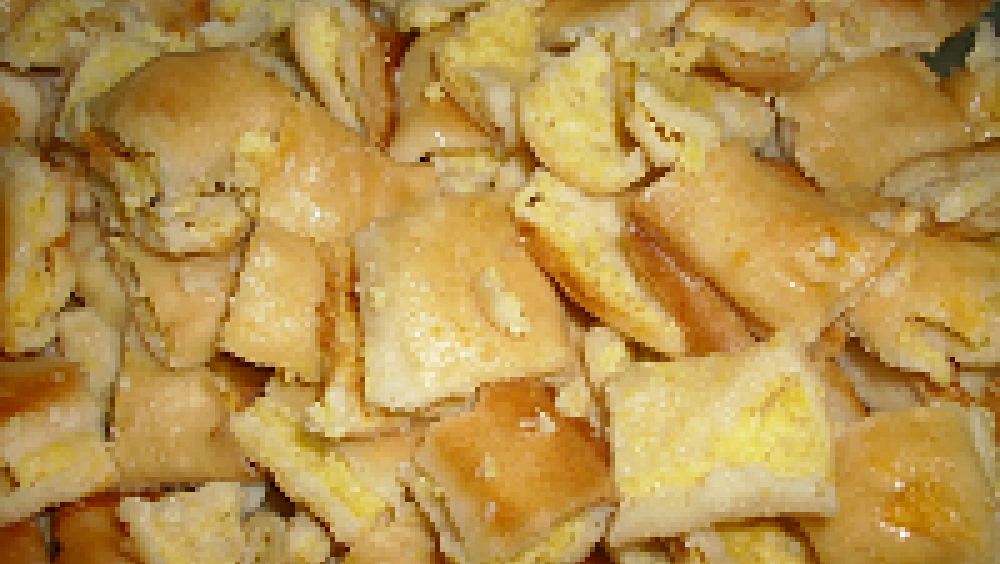Poverty for modern hedonism on the example of border dishes in village Okešinec, Moslavina region, Republic of Croatia
When you don't know where to go, remember where are you coming from. (B. Brkan) The poorest countries have made the most imaginative cuisine, the most famous of the world are: Chinese, Indian or Mexican, and in Croatia regional cuisine in Medimurje and Zagorje. In a more detailed explanation, our regional writer Mrs Bozica Brkan gives the example for the dishes from her native village Okešinec in Moslavina region, particularly: jagli, vankuši, šalata z poparum, makarun/kolačica, baked potatoes…, which we are trying to bring back to the modern table. Product of Croatia is used in an emotional context, but by no means a replacement for inferiority in quality, quantity, idea, choice. Croatia is best defended and best conquers standards, which are not different from European/world. In every area.
Since ancient times writer's family have been considered as border guards, natives, residents of the Military Krajina. Their existence in Okešinec, according toWikipedia, is a settlement in the municipality of Križ in Zagreb County. It extends to 5.71 km2. The population undoubtedly shows the development and desecration of the village: in 1857 it has a population of 473, 1869. It has 397 inhabitants, in 1880 it has a population of 364, in 1890 it has 334 inhabitants, in 1900 it has 399 habitants. The population, in 1910, has a population of 412, in 1921 it has a population of 470, in 1931 it has 600 inhabitants. In 1948 there is 649 dwellings, 1953 has 686 inhabitants, in 1961 it has 743 inhabitants, in 1971 it has 631 inhabitants, in 1981 has 522 inhabitants, in 1991 it has a population of 446, in 2001 it has 430 inhabitants, in 2011 it has 422 inhabitants, and according to the last 2021, it has only 337 inhabitants. Most of the inhabitants were living there in writer's childhood, as censuses from 1953 that is, in 1961 and 1971,say. In the village area is Sipčina, ancient archeological site from the first and second century. The village was created, according to the books, in times of Turkish conquests to the area Military Krajina, first abandonment of the old population in 1552 and resetting immigrants, most likely from the area conquered by the Turks, around 1600 and the first list of the population in 1679. These inhabitants, in the 20th century, were called natives and border guards, and by the development of industry, especially the wood industry in willage Novoselec, to Okešinec came dojdeki, dotepenci, people from different, mostly Croatian regions. With disappearing of inhabitants recently disappeared and very little researched original speech of kekavica. Writer Božica brkan tried to preserve her own native speech the most in her literary and journalistic works. Life's way: After World War II, due to great families and low yields in production, and especially at the time of obligation, the village feels great poverty. Until 1955 her family lived in a family cooperative with five, as many as six generations: šukunbaba, prapradjed,great -grandfather and great -grandmother, parents, aunt and uncle, just born. Of food all that remains, especially quality goes for sale, due to taxes. One pig is slaughtered for the whole year, and even for Christmas they baked young chicken. Mode of production: (gardens, fields, orchards, vineyards, vineyards around the house…): extensively, today it would be called environmentally grown. Mostly dependent on the year, so however. Food preparation: quantitatively modestly, how much there was; from today's perspective. Almost alternative ways to prepare (vegetarian, vegan ... because the meat little and rare,eventually on Sundays and for great saints). Meals: Breakfast/ fruštik: every day žganci z poparu, rarely and only in the wealthier families beli kubanci, prežgana juva (shepherds with rich choices before the morning grazing: either brandy or a piece of bread!) - poor peopleonly bread pledged into wine, if any. Lunch/ obed: The most common seasonal vegetable stew/ čušpajz, baked potatoes na rajngle (with the addition of what there was: with egg, with a black onion, with a fresh pepper, red ground pepper, cream…), in the summer in the field dry (cheese, bacon, meat if there was some). Dinner/ večerja: remains from lunch, gra na ladno, fresh preveli cheese. for a bite between meals: gra na ladno, dry cheese, fruit and some bread, for children potatoes on the table (Vienna: Advent!), mlinci na table, if baked bread and tickled a piece, fruit. Better food, reinforced: heavy work with heavyweights (digging vineyards, harvesting, mowing, machine…), possibly Sunday, Christmas (lots of baked young chicken), weddings, baptisms, karmine (deaths)… - specialty: vajnkuši as an appetizer or a contribution, also specialty as mlinci, unfortunately extinct: cookie/makarun/makaron/palak, festive or holiday, wedding soup/svetešna juva, hen food with noodles, kašica, žličnaki. Nutrition is seasonal character, dependent on the seasons and, for food savings, frequent adhere to the post - at least every Friday, the great posts on the eve of Easter (Lent) and Christmas(Advent).
The story’s European Dimension is to involve the community – especially children, senior citizens, and visitors to discover the connection of modern times and traditional food and old Croatian language in Okesinec, Moslavina region. We would like to learn young people to produce healthy food in their gardens and return to nature, as our ancestors did. It also promotes important values like intergenerational connections, and sustainable rural development. Our idea is to invite everyone who wants to learn about the Moslavina's dishes and ways of preparing food in the past and to save that tradition as well as to preserve old Croatian language from the forgetting. It could become a way to stimulate rural tourism and to promote the cultural heritage (old dishes, old language – kekavica and tradition) of our Moslavina region in Europe.
